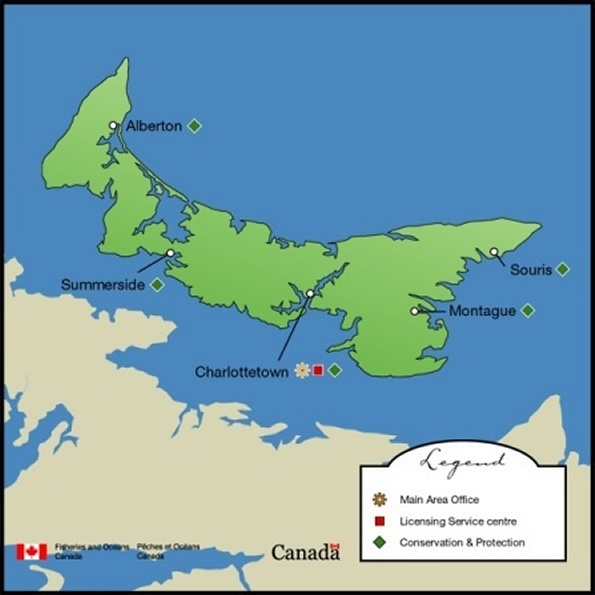
|
The Department of Fisheries and Oceans in the Gulf Region
|
 Prince Edward Island Area
Prince Edward Island Area

Click on the map for a full size version
Prince Edward Island is the only area of DFO whose boundaries coincide with those of a Canadian province. Prince Edward Island faces the Gulf of St. Lawrence to the north and east and shares the waters of Northumberland Strait with eastern New Brunswick and the northern seaboard of Nova Scotia; it has a total area of 5,660 square kilometres. DFO provides fisheries management, licensing and other services from its main office in Charlottetown. There are four detached offices located in the area's main towns, Alberton, Montague, Souris and Summerside. There are some sixty small craft harbours around the island, and the Canadian Coast Guard has facilities in the harbours of Charlottetown and Souris.
The waters around Prince Edward Island are shallow and warm. The sea, inevitably, plays a prominent role in the life of the island and constitutes one of its major sources of income. Not only does it provide professional fishers with numerous species of fish and shellfish, but the bays and estuaries found all around the island afford prime habitat for molluscs and are eminently suitable for aquaculture.
A species of seaweed that is typical of this area, namely Irish moss, grows along the coastlines of Prince Edward Island. Owing to its natural gel-forming properties, Irish moss is a highly prized substance that is used in many types of cosmetics and food products.
The area's fishing fleet consists mainly of the two types of boats used in its two characteristic fisheries: the 40- to 45-foot boats of the inshore fishery, and the dories of the aquaculture industry. Aquaculture is flourishing in Prince Edward Island: every year the value of its products amounts to some $25 million, and it generates nearly $50 million dollars' worth of economic activity in all. The island supplies nearly 85 per cent of all blue mussels sold in North America. Aquaculture operations, virtually all of them producing mussels or oysters, are located at many points around the island, in shallow bays where the water temperature is moderate. Aquaculture is such an important economic sector that DFO has developed management measures expressly designed for it. For example, Prince Edward Island is the only area in Canada where DFO has an aquaculture co-management division.
Co-management enables DFO to adopt an integrated approach to this specific industry, partnering with industry and provincial government representatives.
Prince Edward Island is the smallest Canadian province. It is also the most densely populated, with more than 24 inhabitants per square kilometre (the average figure for Canada as a whole is three inhabitants per square kilometre). The island's rich, mellow soils sustain an intensive and prosperous farming sector. These various factors, taken together, mean that sensitive ecosystems, such as estuaries containing aquaculture operations, are potentially at risk from pollutant or sediment runoff. For that reason, DFO and its partners from government and industry place particular emphasis on environment and habitat protection in this area.

|
How to reach the Prince Edward Island Area
- Area Office:
Department of Fisheries and Oceans
1, Queen St.
Charlottetown, (P.E.I.)
C1A 7M8
Telephone: (902) 566-7812
Fax: (902) 566-7948 - Area Director:
Telephone: (902) 566-7810 - Licensing Service Centre:
Telephone: (902) 566-7814 - Conservation and Protection:
Telephone: (902) 566-7793 - Aquaculture:
Telephone: (902) 566-7849 - Canadian Coast Guard:
Telephone: (902) 566-7812 - Resource Management:
Telephone: (902) 566-7815 - Habitat Management:
Telephone: (902) 566-7839 - Small Craft Harbours:
Telephone: (902) 566-7838 - Science:
Telephone: (902) 566-7825
|
Date Published: 2001-02-09 Last Updated: 2004-02-09 |
Top of the page |
Important notices and disclaimer |
